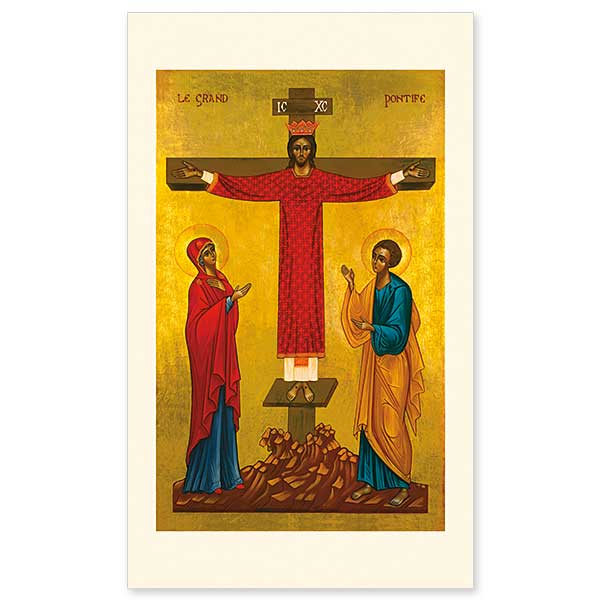

| Cards as shown (No Imprinting) | |||||
| Item Number | Description | Price Each | Quantity | Total | Action |
|---|---|---|---|---|---|
| PCM529 | Package of 25 icon holy cards |
$8.50 |
package |
$8.50 | |
| Item Number | Select Imprinting option: | Price Each | Quantity | Total | Action |
|---|---|---|---|---|---|
| Not Selected |
|
|
cards 30 piece minimum. |
This image by Sr. Marie Paul, OSB, is a synthesis of two classical icons. The first is the Crucifixion; the second is Christ the High Priest. The Crucifixion image has been used from earliest times. A lesser-known icon is that of Christ the High Priest. The depiction originated in the Balkans in the fourteenth century and spread throughout the Orthodox world. Christ is shown on the cross fully vested, both Sacrifice and Intercessor. He is flanked by Mary His mother and St. John the Evangelist.
Icon holy cards are 3" x 5", a convenient size for use as gifts or bookmarks. The backs are blank except for a faint colophon at the bottom, leaving plenty of room for custom imprinting with your own message.
This image by Sr. Marie Paul, OSB, is a synthesis of two classical icons. The first is the Crucifixion; the second is Christ the High Priest. The French title Le Grand Pontife translates literally as “The Great Bridge Builder.” Our word Pontiff is frequently used to refer to the Pope, although it has its origin in the title used for priests of pagan Rome—those who built bridges between the gods and humankind. The Crucifixion image has been used from earliest times. In its most complex form the Blessed Virgin Mary is usually seen with the other women of Jerusalem at the left of Jesus, with St. John the Evangelist and the centurion on his right. Other imagery includes the two thieves, angels hovering above the scene, the temple or the wall of Jerusalem in the background and the skull of Adam beneath the cross. A lesser-known icon is that of Christ the High Priest. This title of Christ comes from the Epistle to the Hebrews (2:17): Therefore he had to become like his brothers and sisters in every respect, so that he might be a merciful and faithful high priest in the service of God, to make a sacrifice of atonement for the sins of the people. The depiction originated in the Balkans in the fourteenth century and spread throughout the Orthodox world. It usually shows Christ dressed as an Orthodox bishop, wearing a crown and sitting on a throne holding an open Bible. He is flanked by St. John and the Blessed Virgin Mary.
The combination of the Crucifixion image with that of Christ the High Priest creates an icon rich with theological symbolism. The most obvious understanding of the image is that of the sacrifice of the Eucharist. Christ is the Priest, the altar and the sacrifice. He offers his body on the altar of the cross and himself acts as the High Priest who intercedes for the human race. St. Paul reminds us that while the sacrifice is made at the crucifixion, it is only when he has ascended that the gift is given to the Father. That is why we see the wounds in his hands and feet while he appears in his resurrected glory.
While on the cross, Jesus imparts to the Theotokos “Woman, here is your son…” and to the Beloved disciple “Here is your mother.” This command represents Christ’s gift of the Church—represented here in the person of Mary. She is depicted wearing a red maphorion symbolizing the flesh she gave to Christ at the Incarnation. It bears three stars which represent her virginity before, during and after the birth of Our Lord. Mary and St. John raise their right hands—a gesture which indicates both an act of homage and intercession for the needs of the Church.
Christ is depicted in his glorified state as the High Priest. Although somewhat stylized, he wears a red chasuble showing his sacrifice on the cross. It is curious that he is not shown with the omophorion, the cross-covered scarf worn by Eastern bishops, similar to a Roman archbishop’s pallium. Just as in some Orthodox churches bishops wear crowns, Jesus is adorned with a crown to show that he is King of Kings. Another unusual feature of this icon is the absence of the halo or nimbus around Christ’s head. Instead of the typical inscription given by Pilate to be placed above Jesus’ head (“This is the King of the Jews”) there is simply the Greek abbreviation of Christ’s name.